|
History Notes Chapter 5, Page 1 of 1 Post Korea: A Time of Change and Adaptation |
|||||||||||||||||
|
Editor's Note: Commentary on the last page of the previous chapter closed out the history of the 91st SRS at the close of the Korean War. As the organization moved on in this time of adaptation from both war-time and their additional duties of classified reconnaissance, it was truly a time of change. My RB-29 crew arrived at Yokota in October of 1953, blending into this changing environment. I have asked Colonel Clarence Becker, Commander of the 91st SRS during the second half of my tour, to make comments relating to this time of transition. Here are some of his words:
My RB-29 crew story, found on this web site, describes much of the day-to-day life of an RB-29 crew during this period of change with ever greater emphasis on the classified reconnaissance work that was the basis for our assignment at Yokota. Click here if you wish to check in on this element of the 91st SRS History. Soon after my crew departed Yokota for the States, in the early summer of 1954, preparations were in the works to move the 91st SRS back to the U.S. and leave the reconnaissance mission in the hands of a new unit, under FEAF control, designated as the 6091st RS. The squadron held a “37th Anniversary of the 91st Strategic Reconnaissance Squadron” party at the Yokota Air Base on Friday, 20 August 1954. Soon after, Colonel Becker departed for stateside duty (September 1954), leaving command of the new organization in the hands of the most senior of the senior officers currently assigned to the unit. Lt. Colonal Gandy was the A/C of one of our crews and he was soon designated as the new Squadron Commander of the new 6091st RS, a position he held until August of 1956. Given the opportunity, I would be remiss in not providing some data relating to the early history of the 6091st Squadron. To my good fortune, one of our web site visitors has been S/Sgt Morris E. “Gene” Nelson, who was an active crewmember, flying classified missions, which, for him, began during 1955. He has provided some text and related illustrations that offer an appropriate closing set of notes relating to the evolving 91st SRS mission, flying out of Yokota. You may jump over to that story by clicking here, with an easy return to this page of the 91st SRS History Story. Looking for a Tactical Solution At Great Falls AFB, Montana and Larson AFB, Washington, the 91st began experimenting with reconnaissance operations involving fighter aircraft. The hard lessons learned from the Korean War and other reconnaissance missions was that our aircraft were often times not able to outrun enemy fighters sent up to shoot or force them down. The U.S. needed a faster platform which also had the range of the larger, slower reconnaissance aircraft being used for reconnaissance work. |
|||||||||||||||||
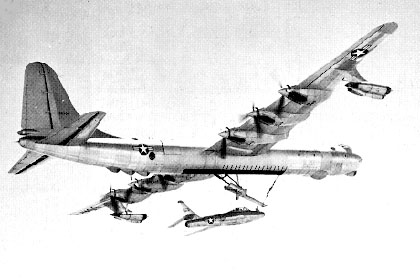 |
|||||||||||||||||
|
|
|||||||||||||||||
| (Editors note: If you would like to learn more about the YRF-84F and the GRB-36F, click on these URLs to the USAF Museum, WPAFB, and use your back button to return to this page.
YRF-84F: http://www.wpafb.af.mil/museum/annex/an4.htm GRB-36F: http://www.wpafb.af.mil/museum/research/bombers/b3-80.htm The 91ST conducted an operational procedure called the Fighter-Conveyence (FICON) system. FICON used two aircraft: a B-36 to function as the “mother” ship and provided the needed range and a modified F-84 jet aircraft to function as the high-speed reconnaissance aircraft. The specially-designed RF-84K’s would be ferried close to the projected target location, be launched in flight, make a high speed pass over the target, and then be retrieved and ferried back to its home base of operations. The jet reconnaissance pilots would enter and exit their RF-84 through the B-36’s bomb bay to fly away to conduct their reconnaissance missions. |
|||||||||||||||||
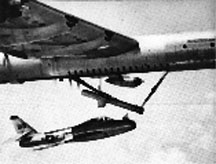 |
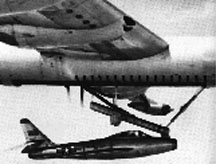 |
||||||||||||||||
Experimentation began in early 1955 and the first successful hook-up in December 1955. In January 1955, the 91st began FICON missions on a regular schedule. The hook-ups were very perilous and many near fatal accidents occurred during this operation. These “strategic/tactical” reconnaissance missions were only short-lived however. This could be due, in part, with the development of new reconnaissance aircraft--the high-altitude U-2--which made the need for more vulnerable reconnaissance aircraft to conduct strategic reconnaissance obsolete. |
|||||||||||||||||
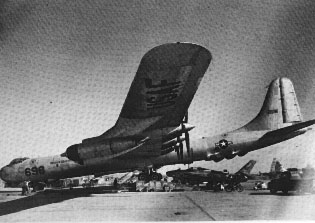 |
|||||||||||||||||
|
bomb bay of B-36 aircraft |
|||||||||||||||||
| No longer needed for a long-range, strategic reconnaissance mission, the 91st was inactiviated for the first time in its 50 year history on 1 July 1957. (2) |
|||||||||||||||||
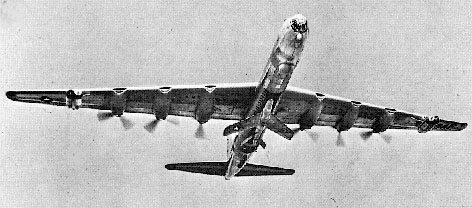 |
|||||||||||||||||
|
|
|||||||||||||||||
| While the operational use of the B-36/RF-84K FICON program to collect essential strategic intelligence was very short-lived, it shows the extent in which Air Force leaders were willing to go in order to secure strategic intelligence on our Cold War adversary—the Soviet Union. Efforts are currently underway at the USAF Museum at Wright-Patterson AFB to build a Cold War addition. The USAF Museum has a refurbished RF-84K aircraft on display and it is the unit’s hope that this unique mission will be included as part of the future Cold War exhibit.
The 91st Strategic Reconnaissance Squadron was returned to a dormant state through inactivation in July 1957. |
|||||||||||||||||
|
jet aircraft modified with a sloped tail and hook mechanism - 1954 (4) |
|||||||||||||||||
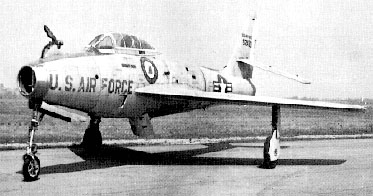 |
|||||||||||||||||
|
1. Rolling Thunder, Freeman Westel, Wings: A Sentry Magazine, Volume 23, Number 5, October 1993, pages 20-22. 2. Unarmed and Unafraid, Glen B. Infield, New York: Macmillan Company, 158. 3. Ibid. 4. Photo given to author at 91st Reunion in Savannah (March 14, 2002). |
|||||||||||||||||
|
End of Page 1 of 1 Pages, Chapter 5 go to Chapter 6 Cover — Table of Contents — Introduction Chapters — 1 — 2 — 3 — 4 — 5 — 6 — 7 |
|||||||||||||||||